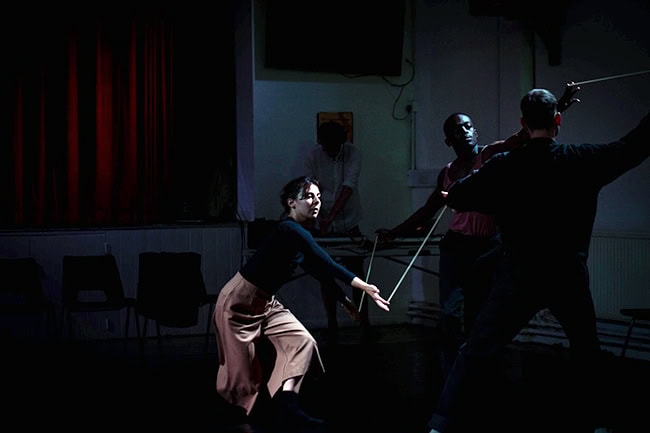Helen Cox, Bodies in Space at the Bloomsbury Festival
Posted: December 25th, 2019 | Author: Nicholas Minns | Filed under: Festival, Performance | Tags: Andrew Oliver, Bloomsbury Festival, Bodies in Space, Dougie Brown, Fabio Iocco, Helen Cox, Jordan Ajadi, Natasha Arcoleo, Pink Floyd | Comments Off on Helen Cox, Bodies in Space at the Bloomsbury FestivalHelen Cox, Bodies in Space, Bloomsbury Festival, Goodenough College, October 13

Dancers are often urged to ‘explore space’ in class, but choreographer Helen Cox has taken this encouragement far outside the walls of a studio in her new work, Bodies in Space, at the Bloomsbury Festival. Teaming up with composer Dougie Brown, she has choreographed a trio to the sounds of the stars. Actually, as Professor Fabio Iocco clarified in a post-show talk, we can’t hear the stars because there are no molecules in space through which sound can vibrate, but there are recordings of light emitted from stars far beyond our solar system captured by NASA’s Kepler space telescope. What Brown has done is to take two available sources of this data, mapped their topographical qualities and then processed the results with reverb and granular synthesis to produce what to the layman’s ears is the sound of the stars. It’s not quite as catchy as Pink Floyd’s Interstellar Overdrive, but all the more affecting for being close to the real thing. Adding movement to this sonic sense of mystery, three dancers — Natasha Arcoleo, Jordan Ajadi and Andrew Oliver — move with planetary suspension through a subtly darkened space in a hall of London House (part of Goodenough College in Bloomsbury), displaying in equal measure both a resistance to, and a celebration of gravity. Having seen Cox dance previously, this is the way she moves, but while Bodies in Space is the first time she has remained on the outside of a creation, the transposition clearly has not affected her choreographic intuition.
The audience is seated on four sides of the open floor, delineating the physical perimeter of the hall but not limiting the kind of spatial universe the dancers imagine as they ease slowly around and in between each other maintaining contact through slender wooden batons stretched between their index fingers with just enough pressure to keep them in place. It’s like linking stars with lines to make a classical astrological figure, but the stars are constantly moving; a dancer may drop a baton but the elastic geometry of the trio is simply suspended until the baton is retrieved and replaced.
It’s the first of a series of choreographic ideas Cox created during an intense two-week period in the studio, in which she plays with the central axis of body movement that arises from stillness and silence. Against Brown’s otherworldly soundscape there is a stealth in the dancers’ articulation, a feline quality that is a mark of muscular control and articulation. Exploring this further in a series of duets, trios and inter-related solos, Cox is clearly inspired by the subject and its intimate relationship to dance; her imagery weaves celestial figures with choreographic form. Arcoleo’s solo starts with swirling circular patterns within the body that expand out into the curvature of the trunk and limbs, while Ajadi seems to flow through the ether, measuring space with his hands in a fluid articulation that knows no boundaries. After a trio in which the dancers move in orbits around each other, Oliver’s solo conjures up the smooth working of an exploratory space arm extending from the fulcrum of his shoulder. They are all visual ideas that have a natural coherence, and in combination with Brown’s soundscape and the sombre lighting of the hall, Bodies in Space gives a corresponding impression of suspended time.
With such a short period of gestation — all too frequent in the socio-political context where space and time equal money — it is such a pleasure to see the distance travelled from Cox’s initial movement ideas in a studio to the outer reaches of the universe and back to this Bloomsbury Festival venue in the heart of London.